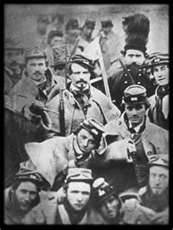The Battle of Gettysburg
Part 1: The Battle Takes Shape In early May, 1863, Robert E. Lee's Army of Northern Virginia won a convincing victory over Gen. Joseph Hooker's Army of the Potomac at the Battle of Chancellorsville. In this battle, Lee had successfully divided his forces even though they had been outnumbered 2-1 to begin with, and the result was a smashing victory, aided also by a surprise attack by Thomas "Stonewall" Jackson. This battle cemented Lee's reputation as a brilliant military tactician, one who could achieve victory despite odds stacked against him. However, Lee's army lost one of its most valuable assets when Jackson, one of Lee's most trusted and successful generals, was shot by friendly fire and later died.
The Army of Northern Virginia, 72,000 men strong, wended its way into the North, aiming to threaten large Northern cities like Baltimore, Philadelphia, and even Washington, D.C., itself. After the loss of Jackson, Lee had reorganized one corps of the army into two, with lieutenant-generals A.P. Hill and Richard Ewell gaining corps commands. Retaining command of the First Corps was Lt. Gen. James Longstreet, architect of the defensive strategy that had been so effective in previous battles, mainly at Fredericksburg. Leader of the cavalry division was Maj. Gen.J.E.B. Stuart, who had been a great help in the past by delivering to Lee precise information on enemy movements and strength. The Army of the Potomac, meanwhile, was still strong (at 94,000 men), still under the command of "Fighting Joe" Hooker, and still smarting from the defeat at Chancellorsville. Union troops shadowed Confederate troops for a time, as Lee's army moved through Maryland and into Pennsylvania. This resulted in a few skirmishes along the way, but the main elements of the two armies didn't intersect directly until late June and early July. On June 26, a division of Confederate troops occupied the Pennsylvania town of Gettysburg, strategically placed at a crossroads. The troops, under the command of Maj. Gen.Jubal Early, burned a few railroad cars and a covered bridge and laid waste the telegraph lines and rail lines leading into the town, then left. A few days later, Lee, aware of the relative proximity of Hooker's army, ordered a major concentration of his forces in Cashtown, eight miles west of Gettysburg. Hooker and President Abraham Lincoln disagreed on how best to confront Lee's invasion force. The result was yet another new commander of the Army of the Potomac, George Gordon Meade. Meanwhile, Stuart and a large part of his cavalry division departed on a reconnaissance mission, to ride around the east flank of the Union army known to be in the area. Stuart's mission took several days to complete. Next page > The Importance of the High Ground > Page 1, 2, 3 |
|
Social Studies for Kids
copyright 2002–2024
David White



 After the victory at Chancellorsville, Lee won approval for another invasion of the North. (The previous one had been stopped by Gen.
After the victory at Chancellorsville, Lee won approval for another invasion of the North. (The previous one had been stopped by Gen. 
